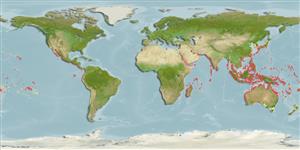Common names from other countries
Environment: milieu / climate zone / depth range / distribution range
Écologie
; profondeur 0 - 7 m (Ref. 100956). Tropical
Indo-Pacific.
Length at first maturity / Taille / Poids / Âge
Maturity: Lm ? range ? - ? cm Max length : 3.5 cm SHL mâle / non sexé; (Ref. 349); common length : 2.5 cm SHL mâle / non sexé; (Ref. 349); âge max. reporté: 12 années (Ref. 8702)
Description synthétique
Morphologie
Shell thick, globose with a flat spire, width clearly greater than its length. Outer lip with small dentickles at the inner margin (Ref. 128042).
Collected for its edible flesh and for its shell in various localities of the area (Ref. 349). Abundant in rocky shores, forming dense colonies in upper mid-tidal pools, on damp and submerged rocks and in crevices (Refs. 349, 128042). Occurs at the mid tide mark (Ref. 349). Also found amongst Mytilisepta virgata beds on exposed shores (Ref. 126136).
Life cycle and mating behavior
Maturité | Reproduction | Frai | Œufs | Fécondité | Larves
Members of the order Neritopsina are mostly gonochoric and broadcast spawners. Life cycle: Embryos develop into planktonic trocophore larvae and later into juvenile veligers before becoming fully grown adults.
Poutiers, J.M. 1998. (Ref. 349)
Statut dans la liste rouge de l'IUCN (Ref. 130435)
statut CITES (Ref. 108899)
Not Evaluated
Not Evaluated
Menace pour l'homme
Harmless
Utilisations par l'homme
Pêcheries: commercial
| FishSource |
Outils
Sources Internet
Estimates based on models
Preferred temperature
(Ref.
115969): 23 - 29.3, mean 28.3 (based on 3772 cells).
Vulnérabilité
Low vulnerability (10 of 100).
Catégorie de prix
Unknown.
